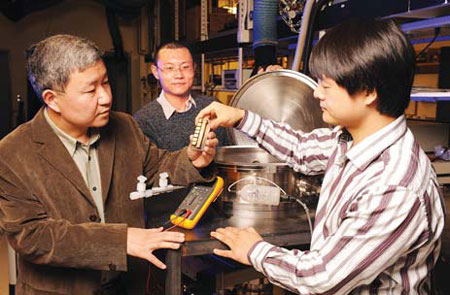Iowa sees jump in enrollment of Chinese students in universities
Updated: 2012-02-17 07:53
By Kelly Chung Dawson (China Daily)
|
||||||||
|
Associate Professor Wang Xinwei (left) and a student and a research associate study the thermal conductivity of organic materials at Iowa State University's Applied Sciences Complex in Ames, Iowa. [Bob Elbert / for China Daily] |
DES MOINES, Iowa - Following a nationwide trend, Iowa's universities have seen a rapid surge of enrollment by Chinese students in the past few years, according to officials.
At Iowa State University, Chinese undergraduate enrollment grew from 72 students in 2002 to 1,212 this year. At the University of Iowa, the enrollment of Chinese undergraduate and graduate students went from 591 in 2005 to 1,737 last year.
"The increase is due primarily to a combination of a growing Chinese middle class and the growing ability of families in China to afford to send students to the US, combined with the belief of Chinese families that students will get both a good education and a stronger proficiency in English," said James Dorsett, director of Iowa State's international students and scholars office.
Additionally, Chinese universities have become much more competitive in recent years, said Russell Ganim, director of the University of Iowa's world languages division. Admission standards have become more stringent, making Western institutions an attractive alternative, he said.
"While there's a huge selection of universities in China, there are so many college-age students who can't get into Chinese universities that they have to seek opportunities in the US, Canada, the UK and elsewhere," Ganim said. "You could call it 'education outsourcing in reverse.'"
Patricia Parker, associate director of admissions at Iowa State, said that the university recruits heavily in China. In the past few years, the US State Department has responded to concerns voiced by various universities that visa application standards were too rigid, she said.
"It has become much easier for students from China to get a visa," Parker said. "So we have worked hard to let people in China know that Chinese students are welcome here in Iowa."
One major development in recent years has been the increase in Chinese students who choose to return to China after graduation, Dorsett said.
"In the past, many of the Chinese students would have counted on doing the 12-month, post-graduation Optional Practical Training period of work experience here in the US," he said. "Up until a few years ago, it was practically a given that students would do the OPT (Optional Practical Training) and then try to get sponsorship from an American company for permanent residency. Some students still go down that path, but more and more Chinese students are now choosing to go home."
Dorsett said that the increase of students who forgo OPT is due to the job shortage in the US and an increase in job opportunities in China.
"The US job market is not that friendly to international students," Parker said. "I've heard students say, 'Companies won't even interview me because they know I would have to leave after the training period.' US companies don't want to pay to convert their visas or sponsor them, so they're much more likely to choose a candidate who doesn't have to deal with visa issues."
Jiang Ziyu, president of Iowa State's Chinese Students and Scholars Association, agreed.
"It's difficult for Chinese students or other international students to find a job here, or even internship opportunities. China is developing so fast, and there are so many prospects back in China. We feel more confident returning to China now."
For students returning to China after graduation, a degree from an American institution is still considered very valuable, Dorsett said.
"There is a perception that a Western education will give students a leg up in their careers," he said.
The increase in Chinese enrollment at Iowa's universities has been mirrored by an increase in American students studying Chinese, Ganim said. The growth in both groups has allowed for more cultural exchange opportunities.
"Having more Chinese students on campus naturally raises awareness of Chinese culture," he said. "More and more students are becoming interested in China and Chinese language, and there are more opportunities for conversation partnerships and activities."
China Daily

 Relief reaches isolated village
Relief reaches isolated village
 Rainfall poses new threats to quake-hit region
Rainfall poses new threats to quake-hit region
 Funerals begin for Boston bombing victims
Funerals begin for Boston bombing victims
 Quake takeaway from China's Air Force
Quake takeaway from China's Air Force
 Obama celebrates young inventors at science fair
Obama celebrates young inventors at science fair
 Earth Day marked around the world
Earth Day marked around the world
 Volunteer team helping students find sense of normalcy
Volunteer team helping students find sense of normalcy
 Ethnic groups quick to join rescue efforts
Ethnic groups quick to join rescue efforts
Most Viewed
Editor's Picks

|

|

|

|

|

|
Today's Top News
Health new priority for quake zone
Xi meets US top military officer
Japan's boats driven out of Diaoyu
China mulls online shopping legislation
Bird flu death toll rises to 22
Putin appoints new ambassador to China
Japanese ships blocked from Diaoyu Islands
Inspired by Guan, more Chinese pick up golf
US Weekly

|

|








